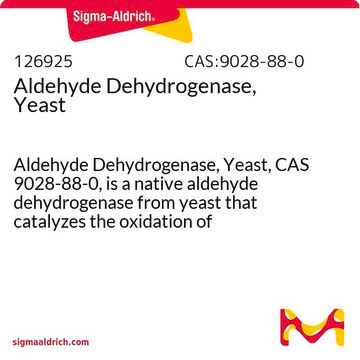A6338
Aldehyde Dehydrogenase, potassium-activated from baker′s yeast (S. cerevisiae)
lyophilized powder, ≥2.0 units/mg protein
Synonym(s):
Aldehyde:NAD[P]+ oxidoreductase
Sign Into View Organizational & Contract Pricing
All Photos(3)
About This Item
Recommended Products
form
lyophilized powder
specific activity
≥2.0 units/mg protein
mol wt
228 kDa
composition
Protein, ≥5.0% biuret
shipped in
dry ice
storage temp.
−20°C
General description
Aldehyde dehydrogenase is a tetramer and has several different isoforms. The enzyme tested in 0.01 M pyrophosphate buffer shows a sharp optimum around pH 9.3 with acetaldehyde as substrate. Potassium ions and cysteine are essential for the enzyme′s activity. Rubidium or NH4+ can be substituted for K+, and glutathione for cysteine. Lithium, Na+, and Cs+ inhibit the reaction. Aldehyde dehydrogenase is inhibited by propylurea, crotonaldehyde, n-propyl isocyanate, cyclohexyl isocyanate, 1-n-propyl-1-[(4-chlorophenyl)sulphonyl]-3-n-propylurea, and 1-methyl-1-[(4-chlorophenyl)sulphonyl]-3-n-propylurea. The enzyme may be utilized to quantitate aldehydes present in blood.
Aldehyde dehydrogenase (ALDH) is present in the nucleus, cytosol, mitochondria and endoplasmic reticulum of cells.
Application
Aldehyde dehydrogenase (ALDH) has been used to evaluate the effects of pear extracts on ALDH activity. It has also been used to colorimetrically determine ethanol by monitoring the enzymatic reduction of nicotinamide adenine dinucleotide (NAD).
Biochem/physiol Actions
Aldehyde dehydrogenase from baker′s yeast catalyzes the reduction of pyridine nucleotides by several aldehydes. It catalyzes the oxidation of a wide range of substrates, such as acetaldehyde, formaldehyde, propionaldehyde, n-butylaldehyde, isobutylaldehyde, n-valeraldehyde, caproaldehyde, benzaldehyde, glycoaldehyde, D-glyceraldehyde, malonic semialdehyde, and succinic aldehyde. Aldehyde dehydrogenase is used to study the production of ethanol and isobutanol. Ethanol concentration can be determined colorimentrically by monitoring the enzymatic reduction of nicotinamide adenine dinucleotide (NAD) using alcohol dehydrogenase after preremoval of aldehyde by aldehyde dehydrogenase.
Unit Definition
One unit will oxidize 1.0 μmole of acetaldehyde to acetic acid per min at 25 °C at pH 8.0 in the presence of β-NAD+, potassium and thiols.
Physical form
Contains lactose, potassium phosphate and citrate buffer salts, and mercaptosuccinic acid.
Reconstitution
This enzyme can be dissolved at 0.3 mg/mL in 100 mM Tris-HCl buffer (pH 8.0), containing 0.02% BSA.
Storage Class Code
11 - Combustible Solids
WGK
WGK 3
Flash Point(F)
Not applicable
Flash Point(C)
Not applicable
Personal Protective Equipment
dust mask type N95 (US), Eyeshields, Gloves
Certificates of Analysis (COA)
Search for Certificates of Analysis (COA) by entering the products Lot/Batch Number. Lot and Batch Numbers can be found on a product’s label following the words ‘Lot’ or ‘Batch’.
Already Own This Product?
Find documentation for the products that you have recently purchased in the Document Library.
Customers Also Viewed
A two-stage, two-organism process for biohydrogen from glucose
Redwood MD and Macaskie LE
International Journal of Hydrogen Energy, 31(11), 1514-1521 (2006)
Monoamine oxidase A activity in fibroblasts as a functional confirmation of MAOA variants.
Tessa M A Peters et al.
JIMD reports, 58(1), 114-121 (2021-03-18)
Sergey Stolyar et al.
Molecular systems biology, 3, 92-92 (2007-03-14)
The rate of production of methane in many environments depends upon mutualistic interactions between sulfate-reducing bacteria and methanogens. To enhance our understanding of these relationships, we took advantage of the fully sequenced genomes of Desulfovibrio vulgaris and Methanococcus maripaludis to
Xiao-Jun Ji et al.
Applied microbiology and biotechnology, 85(6), 1751-1758 (2009-09-17)
Ethanol was a major byproduct of 2,3-butanediol (2,3-BD) fermentation by Klebsiella oxytoca ME-UD-3. In order to achieve a high efficiency of 2,3-BD production, K. oxytoca mutants deficient in ethanol formation were successfully constructed by replace the aldA gene coding for
Enzymic determination of acetaldehyde in blood.
F LUNDQUIST
The Biochemical journal, 68(1), 172-177 (1958-01-01)
Our team of scientists has experience in all areas of research including Life Science, Material Science, Chemical Synthesis, Chromatography, Analytical and many others.
Contact Technical Service








